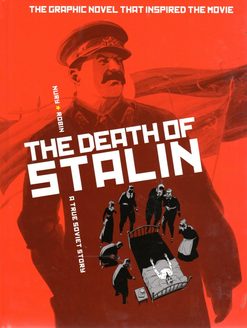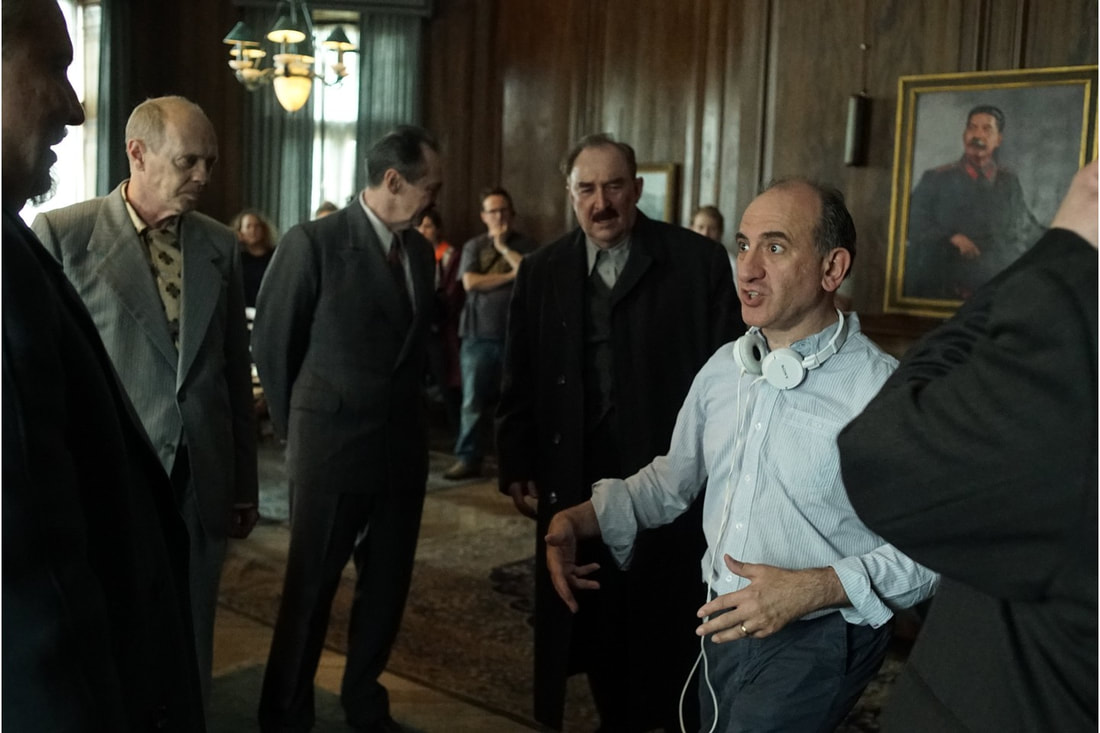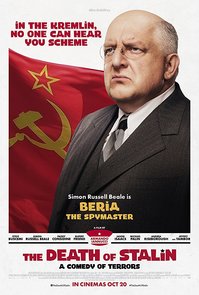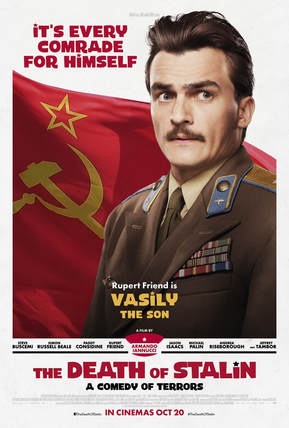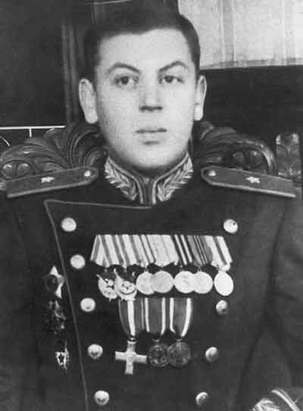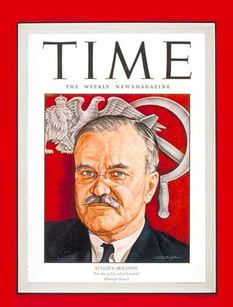The Death of Stalin
Veep's creator's vicious black comedy about a Soviet power struggle
|
The British comic virtuoso Armando Iannucci (the brain behind TV comic series Veep and The Thick of It, directs a very black comedy about the death of the Russian tyrant Josef Stalin in 1953. The movie focuses on the immediate reactions of Stalin's terrified yet relieved closest colleagues as they start manoeuvring in the struggle to gain power. Stalin's drunkard son and coolly manipulative daughter also make an appearance in an increasingly vicious fight to replace the man who ruled Russia for nearly thirty years.
|
SETTING THE SCENE
During the evening of 28 February, Saturday, 1953, Joseph Stalin entertained favoured members of his inner circle -Beria, Malenkov, Khruschev and Bulganin - in his apartment at the Kremlin. They watched a movie, one of Stalin's favourite forms of entertainment. After midnight the five were driven to Stalin's dacha in the outer Moscow suburb of Kuntsevo. The Dacha, with its garden and orchards, was a place of relaxation for the dictator, who also used it conduct official business. During the early hours of the morning Stalin, who liked to show his power by keeping his ministers up very late, presided over a dinner party with the four . As usual it involved heavy drinking. With Stalin intoxicated, and in a good mood, the four dinner guests eventually returned to Moscow at about six in the morning of 1 March.
Stalin liked to work or entertain late and sleep in until late morning. He also liked to to change where he slept as a precaution against assassination. Not even his guards were sure where he slept. Hours elapsed without Stalin making an appearance - not so unusual - but in the evening of 1 March the guards became uneasy and sent a maid in to his quarters to check, on the pretext of handing him some mail.
She found Stalin lying unconscious and incoherent on the floor of the library in a pool of urine. The guards lifted him onto a nearby sofa and phoned Malenkov in Moscow for instructions. He and Khruschev, Beria and Bulganin went to the dacha, where they were told that Stalin was now asleep on a sofa. Nikita Khrushchev claimed they were told that Stalin had been put on a sofa in the small dining room ‘in an unpresentable state’ and was now asleep. The four men, embarrassed and not realising that anything was seriously wrong, went back to Moscow.
Not until the next day, with Stalin paralysed and speechless, were doctors summoned. Almost too frightened to touch him, they announced that he had suffered a massive stroke. The next day, with the dictator paralysed and speechless, doctors called the inner circle back to the dacha. According to Stalin's daughter, who was at the bedside but was not a completely reliable witness, at 9:50 p.m. on 5 March, Stalin's eyes opened "with a terrible look = either mad or angry and full of the fear of death." He lifted his left arm upwards, and died.
The inner circle's visit to the Dacha, Stalin's death and its aftermath is the subject of Iannucci's satire. It has been banned for showing in Russia by Vladimir Putin.
During the evening of 28 February, Saturday, 1953, Joseph Stalin entertained favoured members of his inner circle -Beria, Malenkov, Khruschev and Bulganin - in his apartment at the Kremlin. They watched a movie, one of Stalin's favourite forms of entertainment. After midnight the five were driven to Stalin's dacha in the outer Moscow suburb of Kuntsevo. The Dacha, with its garden and orchards, was a place of relaxation for the dictator, who also used it conduct official business. During the early hours of the morning Stalin, who liked to show his power by keeping his ministers up very late, presided over a dinner party with the four . As usual it involved heavy drinking. With Stalin intoxicated, and in a good mood, the four dinner guests eventually returned to Moscow at about six in the morning of 1 March.
Stalin liked to work or entertain late and sleep in until late morning. He also liked to to change where he slept as a precaution against assassination. Not even his guards were sure where he slept. Hours elapsed without Stalin making an appearance - not so unusual - but in the evening of 1 March the guards became uneasy and sent a maid in to his quarters to check, on the pretext of handing him some mail.
She found Stalin lying unconscious and incoherent on the floor of the library in a pool of urine. The guards lifted him onto a nearby sofa and phoned Malenkov in Moscow for instructions. He and Khruschev, Beria and Bulganin went to the dacha, where they were told that Stalin was now asleep on a sofa. Nikita Khrushchev claimed they were told that Stalin had been put on a sofa in the small dining room ‘in an unpresentable state’ and was now asleep. The four men, embarrassed and not realising that anything was seriously wrong, went back to Moscow.
Not until the next day, with Stalin paralysed and speechless, were doctors summoned. Almost too frightened to touch him, they announced that he had suffered a massive stroke. The next day, with the dictator paralysed and speechless, doctors called the inner circle back to the dacha. According to Stalin's daughter, who was at the bedside but was not a completely reliable witness, at 9:50 p.m. on 5 March, Stalin's eyes opened "with a terrible look = either mad or angry and full of the fear of death." He lifted his left arm upwards, and died.
The inner circle's visit to the Dacha, Stalin's death and its aftermath is the subject of Iannucci's satire. It has been banned for showing in Russia by Vladimir Putin.
The Graphic Novel Behind the Movie
The movie is very much based on a French graphic novel, written by Fabian Nury, and cleverly illustrated by Thierry Robin and Lorien Aureyee.
The movie is very much based on a French graphic novel, written by Fabian Nury, and cleverly illustrated by Thierry Robin and Lorien Aureyee.
Stalin's Secret Dacha
A 'dacha' is a Russian 'holiday home' or seasonal residence, usually located in a a pleasant semi-rural area on the outskirts of Russian cities or picturesque holiday resort areas. Gardens and orchards are usually attached. Dachas vary in size, from large cottages to elaborate villas. Some have few amenities, other are luxuriously outfitted. In the 19th Century Russia's Czars gifted them to favourites or used tham as rewards for services rendered. This tradition was continued after the 1917 Revolution by the Communist leadership, especially by Stalin, who awarded himself several dachas in various pleasant parts of Russia. He personally owned this particular dacha as well as the others he visited.
Stalin used Kuntsevo Dacha -known as the Near Dacha) - during weekends, and even during summer weeks. Located 10 miles from Moscow, and built in 1934 by the secret police (then called OGPU), the wooden building had at least ten rooms, plus a long veranda, where the dictator would often sit in winter, bundled op and covered with furs.There was a banqueting hall used for entertaining guests and for meetings with his Politburo.
he Near dacha, located in a thick wood, was surrounded by a solid fence 4-5 meters high. There was also a tennis court, a croquet lawn and a volleyball court. A large garden area had fruit trees, strawberries and other berry bushes, as well as a rose garden and a shaded grove for mushrooms. The kitchen had a traditional Russian stove with a large oven for baking bread. Stalin would stretch out on a board above the oven when troubled by rheumatism and attacks of radiculitis (inflammation of nerves).
There was a second floor to the building, with bedrooms for Stalin's daughter and her family, but she disliked the dacha and rarely stayed there and the second floor seems to have been largely gloomy, empty and largely unused.
The dacha and Stalin were protected by scores of bodyguards, inside and out.
he Near dacha, located in a thick wood, was surrounded by a solid fence 4-5 meters high. There was also a tennis court, a croquet lawn and a volleyball court. A large garden area had fruit trees, strawberries and other berry bushes, as well as a rose garden and a shaded grove for mushrooms. The kitchen had a traditional Russian stove with a large oven for baking bread. Stalin would stretch out on a board above the oven when troubled by rheumatism and attacks of radiculitis (inflammation of nerves).
There was a second floor to the building, with bedrooms for Stalin's daughter and her family, but she disliked the dacha and rarely stayed there and the second floor seems to have been largely gloomy, empty and largely unused.
The dacha and Stalin were protected by scores of bodyguards, inside and out.
Director Amando Ianucci at work on set of Death of Stalin
Stalin's Death: Natural Causes or Murder?
Stalin was seventy-three at the time of his death. He had two distinctive physical disabilities. A childhood episode of smallpox left his face scarred with that diseases distinctive pockmarks (which were obliterated in Soviet photos and paintings. His left arm seemed slightly withered, possibly from an injury at birth or during childhood, so that his left elbow would not bend properly. By the mid-1930s Stalin had problems with standing and walking, and complained of muscular discomfort and nerve pains in his arms and legs. The dictator insisted that immersion in 'medicinal' spas helped ease such discomforts; consequently he increasingly took longer and longer working holidays in several Russian spa towns. After 1945 he made increasingly fewer official appearances, disappearing from public view for months. By 1952 Stalin was diagnosed with arteriosclerosis and was becoming even more paranoid than usual.
On 7 March 1953 the autopsy results were published. It mentioned Stalin's recent history of high blood pressure and artio- sclerosis and declared that Stalin died of “hypertensive cerebral hemorrhagic stroke plus multiple lacunar infarcts (blockages of small arteries in the brain) secondary to uncontrolled hypertension.” Concealed from this autopsy result until 2011 was evidence of "cardiac hemorrhage, gastrointestinal hemorrhage, and adrenal hemorrhage." The initial autopsy also declared that the fatal stroke had been so severe that no measures could have prevented his death. No mention was made of the suspiciously long interval between the dictator's collapse into coma and the arrival of medical assistance. Was Stalin deliberately denied urgent medical attention in order to ensure his death, aware of rumours that he was planning to purge some of them ? There were rumours that Stalin had been poisoned by being given a dose of warfarin while being treated. Or was it simply that his inner circle were justifiably terrified of him, and feared that if he suddenly recovered he would accuse them of having a hand in his illness and strike them down?
The members of Stalin's inner circle who are depicted in the movie - Beria, Molotov, Malenkov, Khruschev, as well as armed forces chief Zhukov - were in fact concerned that their increasingly paranoid leader intended to return to the terror of the 1930s with their mass arrests, torture, violent deaths and incarceration of thousands in the Gulag. And each man feared that he might be the next high-level victim of Stalin's ruthlessness.
Stalin's Death: Natural Causes or Murder?
Stalin was seventy-three at the time of his death. He had two distinctive physical disabilities. A childhood episode of smallpox left his face scarred with that diseases distinctive pockmarks (which were obliterated in Soviet photos and paintings. His left arm seemed slightly withered, possibly from an injury at birth or during childhood, so that his left elbow would not bend properly. By the mid-1930s Stalin had problems with standing and walking, and complained of muscular discomfort and nerve pains in his arms and legs. The dictator insisted that immersion in 'medicinal' spas helped ease such discomforts; consequently he increasingly took longer and longer working holidays in several Russian spa towns. After 1945 he made increasingly fewer official appearances, disappearing from public view for months. By 1952 Stalin was diagnosed with arteriosclerosis and was becoming even more paranoid than usual.
On 7 March 1953 the autopsy results were published. It mentioned Stalin's recent history of high blood pressure and artio- sclerosis and declared that Stalin died of “hypertensive cerebral hemorrhagic stroke plus multiple lacunar infarcts (blockages of small arteries in the brain) secondary to uncontrolled hypertension.” Concealed from this autopsy result until 2011 was evidence of "cardiac hemorrhage, gastrointestinal hemorrhage, and adrenal hemorrhage." The initial autopsy also declared that the fatal stroke had been so severe that no measures could have prevented his death. No mention was made of the suspiciously long interval between the dictator's collapse into coma and the arrival of medical assistance. Was Stalin deliberately denied urgent medical attention in order to ensure his death, aware of rumours that he was planning to purge some of them ? There were rumours that Stalin had been poisoned by being given a dose of warfarin while being treated. Or was it simply that his inner circle were justifiably terrified of him, and feared that if he suddenly recovered he would accuse them of having a hand in his illness and strike them down?
The members of Stalin's inner circle who are depicted in the movie - Beria, Molotov, Malenkov, Khruschev, as well as armed forces chief Zhukov - were in fact concerned that their increasingly paranoid leader intended to return to the terror of the 1930s with their mass arrests, torture, violent deaths and incarceration of thousands in the Gulag. And each man feared that he might be the next high-level victim of Stalin's ruthlessness.
The Struggle for Power: the Cast
Laventri Beria on 'Time' magazine cover, 1953 (left). In the movie he is portrayed by Simon Russell Beale. The photo(late 1930s) shows the bespectacled Beria with Stalin's daughter Svetlana on his knee. Stalin works away in the background, apparently unconcerned about Beria's well-deserved reputation as a rapist and child molester.
Beria, like Stalin, came from Georgia. Stalin referred to him admiringly as "my Himmler". From the late 1930s to the early 1950s Beria had built up and overseen Stalin's enormous network of slave-labour camps (the 'Gulag Archipelago) while also running the feared secret police network.
In the movie Jeffrey Tambor plays Georgy Malenkov, who in 1953 had the dubious and dangerous reputation as being the man most likely to succeed the dictator.From the civil war onward the shrewd Kremlin hardliner rose rapidly in the party. During Stalin's purges on the 1930s Malenkov was entrusted by Stalin with carrying out many of the campaigns that sent millions to the Gulag. He had a good relationship with Beria, but four months after Stalin's death he was complicit in the decision to execute him.
One day after Stalin's death Malenkov succeeded Stalin as leader for two years but in fact he became part of a collective leadership; his companions were determined to avoid once again having complete power in the hands of one man.
Below: Malenkov as Stalin's puppet, Jeffrey Tambor as Malenkov and Malenkov himself.
Beria, like Stalin, came from Georgia. Stalin referred to him admiringly as "my Himmler". From the late 1930s to the early 1950s Beria had built up and overseen Stalin's enormous network of slave-labour camps (the 'Gulag Archipelago) while also running the feared secret police network.
In the movie Jeffrey Tambor plays Georgy Malenkov, who in 1953 had the dubious and dangerous reputation as being the man most likely to succeed the dictator.From the civil war onward the shrewd Kremlin hardliner rose rapidly in the party. During Stalin's purges on the 1930s Malenkov was entrusted by Stalin with carrying out many of the campaigns that sent millions to the Gulag. He had a good relationship with Beria, but four months after Stalin's death he was complicit in the decision to execute him.
One day after Stalin's death Malenkov succeeded Stalin as leader for two years but in fact he became part of a collective leadership; his companions were determined to avoid once again having complete power in the hands of one man.
Below: Malenkov as Stalin's puppet, Jeffrey Tambor as Malenkov and Malenkov himself.
Vasily Stalin in real life was every bit the drunken, crazy reprobate portrayed by Rupert Friend in the movie. He was Stalin's second son.(The first, Yakov, had been captured by the Germans during Operation Barbarossa and died -or killed himself - in captivity after his father refused a prisoner swap). As a boy Vasily seems to have been hard hot by his mother's suicide. He was a spoilt, wayward and lazy pupil, always taking advantage of being the son of the supreme leader. He gained entry to flying school despite poor grades, and continued to flaunt his privileged position, drink heavily, and chase women.He graduated as a pilot, and would fly when drunk. Yet the vicious-tempered Vasily rose rapidly through the ranks, becoming a colonel when war started, rising to Major-General by war's end, despite his many flaws as a pilot, and a person.Vasily was both loathed and feared by those around him; in turn he was scared of his father and of his fate when death removed his father's protection. Indeed, after Stalin died, Vasily was sacked from the airforce and imprisoned for seven years for 'misappropriating' defence funds to pay for his drinking and socialising. Released in 1960 he was soon imprisoned gain for drunk driving, then exiled in Kazan, dying in 1962 in his early 40s.
The "Doctors' Plot"
The Death of Stalin includes a couple of scenes which refer to the shortage of expert doctors to treat the dying dictator. All that are available are a few very elderly medical experts. In a bitter historical irony, Stalin himself was to blame for this situation. After all it was on his orders that the anti-semitic campaign he orchestrated after 1945 began to reach its paranoid climax in 1952-52 with what was labelled as "the doctors' plot.'" According to Stalin and Beria a group of eminent Jewish doctors, mainly from Moscow, were conspiring to kill members of the Communist leadership. under orders from American and Russian intelligence agents as part of an international 'Jewish conspiracy.They were imprisoned, tortured and made to sign false confessions. These spurious accusations were followed by more general anti-semitic newspaper reports, many of which focused on Zionist 'threats' to Russia and the dismissal of many Jewish officials and intellectuals from their jobs; some were arrested . Stalin intended the next step to be a series of pogroms throughout the USSR in which Jews would be rounded up and sent to Siberia.
But Stalin died just before the trial was due to start. Within a month it was announced that the doctors were innocent, the 'plot' was a fabrication
One of the most compelling episodes in Death of Stalin is that depicting Stalin's long-serving Foreign Minister Vyacheslav Molotov and his wife Polina Zhemchuzhina, both of whom were longstanding members of the Communist Party. For some years she had held important administrative posts in the Soviet government. The daughter of a Jewish tailor in the Ukraine (her brother migrated to the USA and became a successful businessman) she became a Bolshevik in 1918, then a propaganda commissar in the Red Army during the civil war.In 1921 Polina married the young rising star Molotov and rose rapidly in the government hierarchy and party, becoming a candidate member of the powerful Central Committee in 1939. The couple for a time shared an apartment with Stalin and his young, troubled wife Nadezhda Alliluyeva, who became a close friend of Polina. In November, 1932 Polina comforted an upset Nadezhda after she was been publicly humiliated by Stalin at a banquet. She shot herself later that night; the Russian public was told she had died of appendicitis. Thereafter Stalin apparently intensely disliked Polina, urged Molotov to divorce her and in 1939 told the NKVD to investigate her for "spying". She was reprimanded for "unknowlngly" having contacts with "enemy elements">
At the time of Stalin's death Polina had been imprisoned in the Gulag on Stalin's orders for five years on trumped-up charges of treason. Molotov himself had voted for her arrest during a Politburo [Cabinet] meeting in 1948 - an example of his toadyism and of the terror that he inspired in Russia's political elite.
The real reason for Polina's arrest and imprisonment arose from Stalin's increasing anger at her lifelong outspoken support for Jewish causes, which continues even post-1945 when the increasingly paranoid Stalin was ramping up an anti-semitic campaign in the party, government and the USSR as a whole. During the war she had supported and befriended many of the Jewish Anti-Fascist Committee, attended the Moscow State Jewish Theatre and was on good terms with Golda Meir, the first Israeli envoy to the USSR. Polina even advocated handing over the Crimean region to Jews for settlement.
Immediately after Stalin's death Polina was released from the Gulag and travelled back to Moscow, unaware that the dictator was dead. Reunited with Molotov, her first words were "Where's Stalin?". When Molotov told her Stalin was dead she fainted.
Molotov himself was one of the earliest Bolsheviks. joining the party as a youth before the Revolution, and working with Stalin. By the 1920s Molotov was a key backer of Stalin in the power struggle after Lenin's death. Once Stalin had established primacy by 1930 he appointed Molotov as de facto Prime MInister[ Chairman of the council of People's Commissars]. From then on Molotov took charge of implementing key Stalinist policies: rapid industrialisation, collectivisation of agriculture, downplaying production of consumer goods, then purging so-called opponents of Stalin's policies.
At the time of Stalin's death Polina had been imprisoned in the Gulag on Stalin's orders for five years on trumped-up charges of treason. Molotov himself had voted for her arrest during a Politburo [Cabinet] meeting in 1948 - an example of his toadyism and of the terror that he inspired in Russia's political elite.
The real reason for Polina's arrest and imprisonment arose from Stalin's increasing anger at her lifelong outspoken support for Jewish causes, which continues even post-1945 when the increasingly paranoid Stalin was ramping up an anti-semitic campaign in the party, government and the USSR as a whole. During the war she had supported and befriended many of the Jewish Anti-Fascist Committee, attended the Moscow State Jewish Theatre and was on good terms with Golda Meir, the first Israeli envoy to the USSR. Polina even advocated handing over the Crimean region to Jews for settlement.
Immediately after Stalin's death Polina was released from the Gulag and travelled back to Moscow, unaware that the dictator was dead. Reunited with Molotov, her first words were "Where's Stalin?". When Molotov told her Stalin was dead she fainted.
Molotov himself was one of the earliest Bolsheviks. joining the party as a youth before the Revolution, and working with Stalin. By the 1920s Molotov was a key backer of Stalin in the power struggle after Lenin's death. Once Stalin had established primacy by 1930 he appointed Molotov as de facto Prime MInister[ Chairman of the council of People's Commissars]. From then on Molotov took charge of implementing key Stalinist policies: rapid industrialisation, collectivisation of agriculture, downplaying production of consumer goods, then purging so-called opponents of Stalin's policies.
Nadezhda Alliluyeva with Stalin above right, 1920s and above left 1930s.



